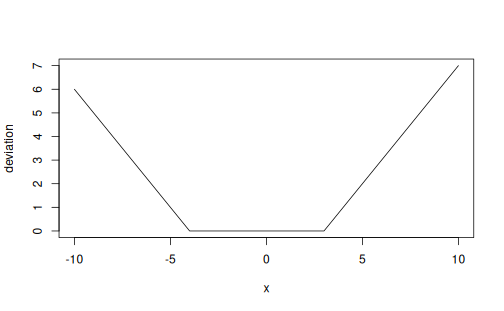This function calculates the deviation in the sense of the Grantham deviation
as introduced by Tavtigian et al. (2006). Essentially, if x lies within the
range [min, max], then dev() returns 0. If x is either below min, or
above max, then dev() returns the absolute difference between x and
min or max, respectively.
Inputs are recycled in the sense of vctrs::vec_recycle().
Details
Here's a plot showcasing dev() with min = -4 and max = 3:
x <- -10:10; min <- -4; max <- 3
plot(x, y = dev(x, min, max), type = 'l', xlab = 'x', ylab = 'deviation')
Examples
# `dev()` returns absolute differences from either min or max (whichever is
# closest).
dev(10, min = -4, max = 4)
#> [1] 6
dev(-10, min = -4, max = 4)
#> [1] 6
# `x` can be a vector
dev(-10:10, min = -4, max = 4)
#> [1] 6 5 4 3 2 1 0 0 0 0 0 0 0 0 0 1 2 3 4 5 6
# `min` and `max` can also be vectors, they will be recycled
dev(-10:10, min = -4:16, max = 4:24)
#> [1] 6 6 6 6 6 6 6 6 6 6 6 6 6 6 6 6 6 6 6 6 6
# If `x` contains `NA` values, then `dev()` will return `NA` for
# those cases
dev(c(10, NA), min = -4, max = 4)
#> [1] 6 NA
# For each calculation of deviation, only either `min` or `max` is used. If
# the unused parameter is `NA` it won't affect the calculation:
dev(c(10, 3), min = c(NA, -4), max = 4)
#> [1] 6 0
dev(c(10, -5), min = -4, max = c(4, NA))
#> [1] 6 1